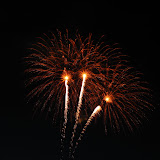 |
| 2007-07-04 fireworks |
Now for what I learned. I really should spend some time reading up on basic photography theory, but here is what I've gathered from trial and error so far. Shutter speed is important for deciding how much action should be captured in an image. The slower the speed the more the image will blur. This part makes sense.
The part that confused me was the f/stop. The f/stop determines how much light will make it through the camera to sensor. The lower the number the more light would make it through. For the most part, I've been shooting images in lower light situations that require the lowest f/stop and as quick of a shutter as I can manage and still see the image. The confusing part was trying to understand why anyone would want to use the f/stop priority setting on my camera.
A Tedious Explanation of the f/stop by Matthew Cole has a solid write up of exactly what the f/stop is. I still don't know why you would want to use the f/stop as the priority, but at least now I know what it is.
All of this leads up to the part that I learned photographing fireworks. A 2 second exposure is juts about enough time to take the shot as soon as the firework explodes. To get a quick capture of what it looks like at any point in time the shutter speed can be moved to 1/2 or 1/5 second. To get a very interesting shot, push the shutter speed up to 4 or 6 seconds and turn the f/stop up to darken the image. This one takes a little guess work to line up the shot, but the result is an exposure that covers the entire life span of the firework.
Lesson Learned : What the f/stop is and how much nicer it is to take a long exposure on a tripod.

2 comments:
f/stops let you determine field of view. one common thing to do with it, is to shoot macro stuff.. really close ups of flowers and bugs and stuff like that. If you see a close up of say.. a bug.. where its head is perfectly in focus, but the background is blured and out of focus.. thats cause of the f/stop... it has a shallow depth of field. Things like that. I remember reading that one of the great innovations in cinema was shooting a scene from FAR away, and zooming in, so you can have the entire scene in focus.
so yea.. if you set fstop as a priority, then you can determine the depth of field or something, and itll set the exposure time to compensate and make sure you get enough light in
As the previous commenter alluded to f/stop controls the depth of field. A wider aperture gives you a shallower depth of field and a smaller aperture gives you a much larger depth of field.
So for portraits and bugs and what not you want to find the correct f/stop to give you focus across the person/bug but render the background out of focus, referred to as bokeh, so that your subject is isolated.
However for landscapes you want a higher f/stop because you want everything to be in focus.
Ah photography, it can be as complex or as simple as you want it to be.
Post a Comment